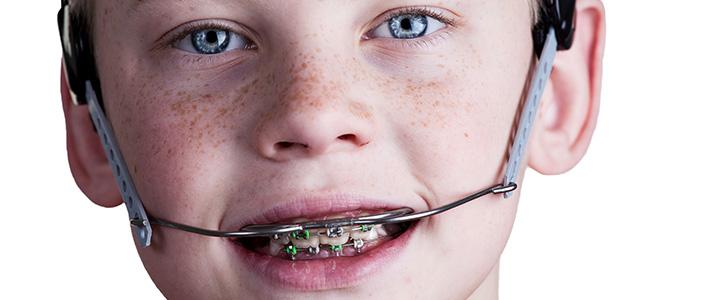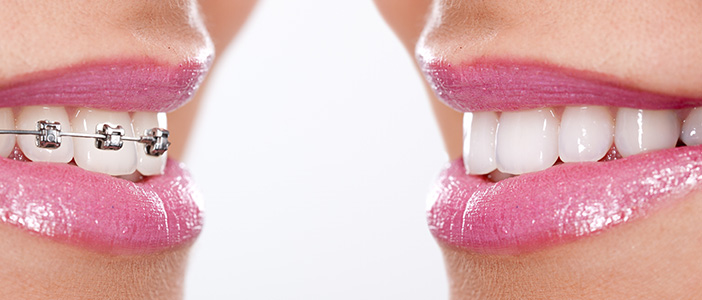Headgear Braces for Adults & Youth: Important Things To Note When You Need Headgear
Headgear — if you’re anyone who’s had braces or considered braces, the thought of possibly needing headgear has likely crossed your mind.
Is headgear still commonly used in orthodontics? And why might an adult need headgear?
We’re summarizing these answers as well as how to find relief from the discomforts of wearing headgear below.
Table of Contents
- Is Headgear Still Used for Adults & Adolescents in Orthodontics?
- Uses for Orthodontic Headgear: Adults vs. Children
- Adolescent vs. Adult Braces: Headgear Timelines & Average Wear Times
- Common Side-Effects of Orthodontic Headgear for Adults and Adolescents
- Biermann Orthodontics: Providing Treatments Including Invisalign, Headgear, & Braces for Adults and Adolescents
Is Headgear Still Used for Adults & Adolescents in Orthodontics?
Orthodontics has been using headgear for well over a century as a key part of many treatment plans. But with new options like Invisalign®, some patients might wonder if headgear is still a necessary treatment option.
Even though headgear isn’t as commonly used now, it’s still a great option for treating many orthodontic issues. Orthodontists look at factors like age, the severity of issues, and treatment goals to figure out if headgear is the right fit for each person. While the landscape of orthodontic treatments has evolved, headgear remains a valuable choice for those who need it.
Uses for Orthodontic Headgear: Adults vs. Children
Headgear is typically used in growing patients to correct overbites by holding back the growth of the upper jaw, allowing the lower jaw to catch up.
Headgear is also used in adults, but for a different reason.
A typical scenario where orthodontic headgear for adults may be necessary is a case where some teeth are extracted, and front teeth are being retracted (pulled backward).
When extraction spaces are being closed, the teeth behind the extraction space slide forward and the teeth in front of the space slide backward. In some situations, to maintain the bite, the orthodontist will not want the back teeth to come forward.
The headgear serves to hold them back (maintain anchorage).
Adolescent vs. Adult Braces: Headgear Timelines & Average Wear Times
The timelines will vary based on the reason for needing the headgear and how long each day an individual should wear the headgear with braces may also vary.
For growing patients, headgear needs to be worn approximately 10-14 hours at a time to be effective in correcting the overbite. The timeline is usually anywhere from 6 -18 months depending on the severity of the overbite and how much a patient is growing.
Orthodontists may recommend that for adults with braces, headgear be worn as much as possible. Realistically for most adults, this might only be wearing their headgear for 8-10 hours per day, but the more the better — even 24 hours would be acceptable.
Common Side-Effects of Orthodontic Headgear for Adults and Adolescents
Although headgear is effective in treating orthodontic issues, it may lead to potential negative effects, such as discomfort and soreness, difficulty sleeping, and self-consciousness.
You may be able to minimize these effects by following your orthodontist’s instructions, which may include adjusting the headgear when necessary, maintaining good oral hygiene, and avoiding certain foods that may damage the appliance.
Combating Soreness & Discomfort
The soreness/tenderness may persist for several days. Usually, the second and third days are the most severe, with a reduction in soreness over the next couple of days.
Ibuprofen and a soft diet are helpful. There is also a device called a “bite wafer,” which is a soft U-shaped piece of rubber that patients can gently squeeze their teeth into. The bite wafer keeps the blood circulating around the teeth and lessens the time teeth might be sore.
Typically, soreness from the headgear and elastics will attenuate and disappear after a few days, but it may persist for as long as a couple of weeks. Very few patients complain of having sore teeth essentially the whole time.
Once the soreness is gone, it is not uncommon for it to flare up again, usually just involving a few teeth. Then the soreness disappears again. Soreness tends to leapfrog among different teeth at different times as a result of tooth movement.
Finding Relief From Soreness & Discomfort Caused By Headgear
The key to the fastest relief of tenderness is to continue to wear headgear/elastics even though the teeth are sore.
Please note that if you stop wearing the headgear or elastics, your teeth will feel better temporarily, but as soon as you resume wearing your headgear, the symptoms will start all over again.
Biermann Orthodontics: Providing Treatments Including Invisalign, Headgear, & Braces for Adults and Adolescents
Our goal at Biermann Orthodontics is to help you achieve the healthy, beautiful smile you’re after.
Choosing an orthodontist is a big decision — which is why we take pride in helping every patient who chooses us for their care.
We’ll work with you every step of the way to ensure that your orthodontic care takes care of your needs. We utilize the latest technology so that we can offer a variety of gentle and safe treatment options customized to your unique care plan.
Ready to be one step closer to a healthier smile? Contact us today to set up your consultation where you can meet our team, learn more about our processes, and discuss treatment options.
Original Article: http://www.archwired.com/headgear.htm
Looking for an orthodontist in Beaverton, Oregon? Biermann Orthodontics is a cutting-edge orthodontic practice that serves Beaverton and Molalla, OR, and focuses on providing world-class customer service and efficient treatment. We strive to create stunning smiles in the shortest amount of time without ever sacrificing quality.
Visit our Locations page to find a clinic near you, or schedule an initial consultation.
Biermann Orthodontics
503-690-0722
17885 NW Evergreen Parkway, Suite 200
Beaverton, OR 97006
The content in this blog should not be used in place of direct medical advice/treatment and is solely for informational purposes.


